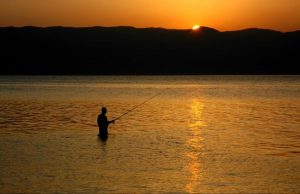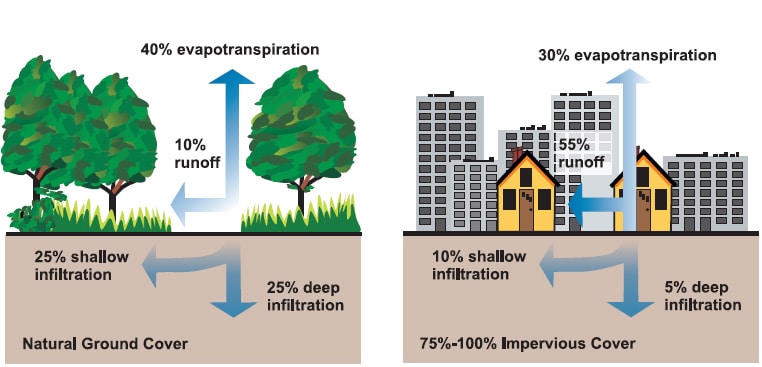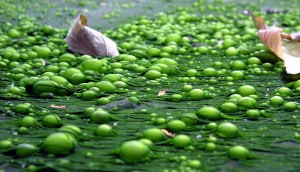Spring — and Stormwater Runoff — Has Sprung
Why Stormwater Runoff is a Serious Concern for Everyone
 Winter if finally over, and spring is in the air. The snow has melted, flowers are blooming, and warmer, sunny days are upon us. But while we are all enjoying the balmier days, we also have to worry about a serious environmental concern: stormwater runoff.
Winter if finally over, and spring is in the air. The snow has melted, flowers are blooming, and warmer, sunny days are upon us. But while we are all enjoying the balmier days, we also have to worry about a serious environmental concern: stormwater runoff.
Stormwater starts as precipitation – snow, sleet, and rain. When this precipitation lands on natural ground cover such as forests, grass, or gardens, it soaks into the ground and is filtered by layers of dirt and rock. This clean, filtered water finds its way to our groundwater and drinking water supply. The problem manifests when stormwater does not land on forests or gardens but instead washes off parking lots, roads, driveways, rooftops, and other hard surfaces, also known as impervious cover. Stormwater that picks up pollution, such as chemicals, oil, road salt, bacteria, sediment, sewage, and trash, then washes these pollutants into ditches and storm drains — and in turn into streams, rivers, ponds, and lakes — is referred to as stormwater runoff. And this spring we should expect an inordinate amount of stormwater runoff resulting from this past winter’s record snowfall.
 The United States Environmental Protection Agency (USEPA) has instituted stormwater regulations under its Clean Water Act. The Clean Water Act aims to protect our nation’s water so that it is clean, drinkable, fishable, swimmable, and healthy. Three specific contaminants of concern are bacteria, phosphorus, and nitrogen, and they must be kept out of the water. Unfortunately, many of our nation’s rivers, streams, and lakes are already widely contaminated by these three pollutants.
The United States Environmental Protection Agency (USEPA) has instituted stormwater regulations under its Clean Water Act. The Clean Water Act aims to protect our nation’s water so that it is clean, drinkable, fishable, swimmable, and healthy. Three specific contaminants of concern are bacteria, phosphorus, and nitrogen, and they must be kept out of the water. Unfortunately, many of our nation’s rivers, streams, and lakes are already widely contaminated by these three pollutants.
According to the Massachusetts River Alliance, stormwater runoff is recognized by the EPA as the #1 source of water pollution in Massachusetts and the primary reason why more than half of its waterbodies are considered impaired. In Maine, stormwater runoff is one of the largest contributors to pollution in Casco Bay and other waterways, and only in July of 2022 received protections under Maine’s updated MS4 permit. In the Casco Bay watershed, it applies to twelve municipalities and regulates stormwater pollution in the most densely populated areas: Scarborough, Cape Elizabeth, South Portland, Portland, Falmouth, Cumberland, Yarmouth, Freeport, Windham, Westbrook, and Gorham.
In Connecticut, stormwater is also a serious problem, where 70 percent of Connecticut’s fresh water bodies are unfit for swimming for part of the year, compared to a nationwide average of 55 percent — and it’s mostly due to stormwater pollution in Long Island Sound. Increases in extreme weather are also contributing to Connecticut’s ongoing stormwater problems.


And New England isn’t the only area of the country with problems. In Ohio and Michigan, Lake Erie continues to be heavily contaminated after several decades. Lake Erie gained notoriety after the Cuyahoga River caught fire in 1969, and the Lake is credited as being the inspiration for both the passage of the Clean Water Act in 1974 as well as the creation of Earth Day. And while Lake Erie’s contamination was largely cleaned up in the 1990’s, it encountered even more serious problems in the new millennium. Algal blooms reappeared in the lake, and with this eutrophication came oxygen deprived dead zones, foul smells, and water too toxic to drink. Then in 2011, Lake Erie’s algal blooms hit a new record by growing to 5,000 square kilometers — or three times the previous record. Lake Erie’s algae blooms are now an annual threat to the health and drinking water of more than 11 million people, where each summer, communities and businesses around Lake Erie actively plan for toxic algae blooms.
 Clearly, stormwater runoff directly causes a myriad of environmental issues. So how can we handle this serious problem? The fact is that there is no simple or quick solution. Addressing stormwater runoff will require a multi-faceted best practice approach that will involve every facet of the nation’s population. Reducing soil erosion, cleaning up pet waste, maintaining healthy septic systems, replacing deicers, improving agricultural practices, implementing cleaner automotive operations, instituting low impact design methodology, and increasing stormwater funding are just a few of the ways that we can begin to solve the problem. In the end, there is no natural resource more precious than water, and we must do everything in our power to protect it.
Clearly, stormwater runoff directly causes a myriad of environmental issues. So how can we handle this serious problem? The fact is that there is no simple or quick solution. Addressing stormwater runoff will require a multi-faceted best practice approach that will involve every facet of the nation’s population. Reducing soil erosion, cleaning up pet waste, maintaining healthy septic systems, replacing deicers, improving agricultural practices, implementing cleaner automotive operations, instituting low impact design methodology, and increasing stormwater funding are just a few of the ways that we can begin to solve the problem. In the end, there is no natural resource more precious than water, and we must do everything in our power to protect it.
